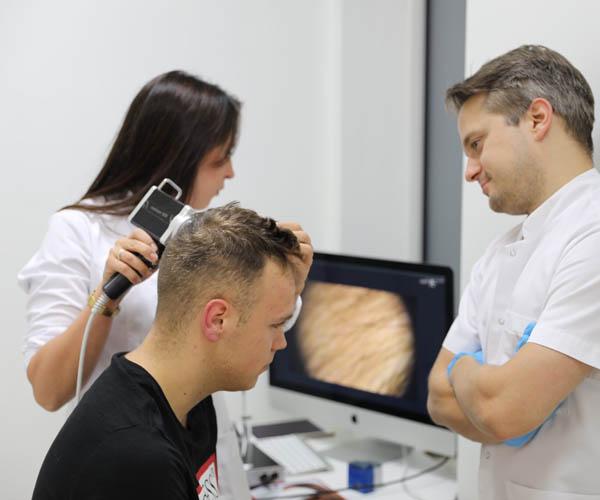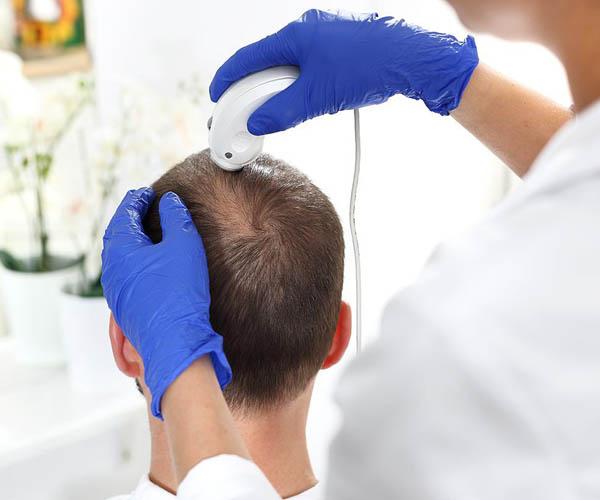Trichoscopy can be an adjunctive tool in diagnosis or form the basis of it and be the main test to determine the nature of a hair or scalp problem.

What is trichoscopy?
Trichoscopy is an advanced, state-of-the-art form of diagnostics that assesses the condition of the scalp and hair. It can help find the cause of hair loss or the formation of lesions on the skin.
Trichoscopy significantly facilitates the selection of treatment and avoids performing more invasive tests. It makes it possible to determine the condition of all layers of the epidermis, dermis and subcutaneous tissue located on the head, as well as to take a close look at the structure of the hair.
Trichoscopic examinations make it possible to determine whether hair is falling out or breaking in a specific area, which is often very difficult to see when performing other trichological examinations.
Indications
Trichoscopic examination should be opted for by all individuals who observe excessive hair loss and brittleness in their hair or sudden thinning of the hair, which begins to be visible during daily functioning. They will also be useful when dealing with androgenetic, telogenetic, scarring or alopecia areata, as well as during hair loss therapy, in order to assess the results.
Trichoscopy will also be a very helpful test for people who have undiagnosed scalp lesions. Examples of such changes include red spots, scales, dry dandruff or excessive irritation and wounds. It is also carried out on people suffering from seborrheic scalp, psoriasis and atopic dermatitis, as well as difficult-to-treat types of ringworm.
Contraindications
Basically, there are no contraindications for trichoscopy as it is completely non-invasive and painless. It is even carried out in people with extremely sensitive and diseased scalp, as well as in the elderly, children and pregnant women. All concerns regarding the course of the procedure can be discussed with the doctor performing the procedure at any time. There is also no need to prepare yourself for the examination. It is enough to wash your hair as usual 24-72 hours before performing trichoscopy.
It is best not to apply any masks, conditioners, gels or rubs to the scalp before the examination. In the period leading up to them, it is also not allowed to dye the hair or perform other hairdressing treatments that may affect the scalp. If such activities were performed in the near term, it is worth waiting a few weeks before carrying out trichoscopic examinations.
The course of the examinations
Trichoscopy involves applying a head to the patient’s scalp, which displays an image on a computer screen. The equipment allows the skin to be viewed at up to 100x magnification and photos of the examination to be taken and saved, greatly facilitating diagnosis. Maximum magnification is helpful, but mostly the skin is viewed by positioning the diagnostic tool in different ways.
Both 20x and 70x magnification can be used. In the first phase, the test is performed without the use of additional specifics. The doctor may then apply an immersion fluid to the skin, which has a specific refractive index and allows to slightly change the resolving ability of the equipment used during the examination. It is used depending on the initial suspicion of the disease and the condition of the scalp.
During the examination, special attention is paid to the lesions, but with the help of a dermatoscope The condition and quantity of hair and hair follicles can also be determined, and the growth phases of individual hairs can be looked at closely – the doctor is able to assess which hairs are currently in the growth phase, the downtime phase, and which are in the dying phase, and determine whether the observed state of affairs is within normal limits. The examination usually takes 20 to 30 minutes.


The images taken during trichoscopic examinations are sent for analysis. Usually about 5 of them are made, taking into account all the parts of the patient’s head that are relevant to the diagnostic process. The study focuses on different areas of the scalp – frontal, temporal and occipital. Thanks to a very accurate image, it is possible to determine, among other things, the number of hairs per section of the patient’s scalp, the number of active, empty and plugged hair follicles and their condition, as well as the rate of scalp exfoliation.
The amount or presence of regrowth hair can also be determined. The results of the study are presented in the form of a trichology report, which includes information about the study, the number of hairs and their diameter or two- and three-hair units. The patient’s skin and hair are examined both quantitatively and qualitatively. Analysis can be done manually or automatically with a dermatoscope, or a video dermatoscope.
Important information
Results
After trichoscopic examinations, there are no irritations, inflammation does not increase, and the problem of hair loss does not worsen. However, they allow us to propose appropriate treatment tailored to the patient’s ailments.
Trichoscopy makes it possible to distinguish between different types of alopecia and to find the cause of scalp problems. It is also useful in identifying the most effective methods to deal with the problem quickly. It is characterized by no need to collect skin or hair samples for testing. There is also no need to shave the skin, which could cause discomfort for some people.
Pictures taken during the trichoscopic diagnosis can be compared at each visit to the doctor. After completing the diagnostic procedure, the Patient receives the test results in paper form, which they can take home with them.
FAQ
How does the trichoscopic examination proceed?
The trichoscopic examination is simple and painless. The doctor applies a trichoscopy device to the scalp and observes a magnified image of the skin and hair on a monitor.
What is trichoscopy used for?
Trichoscopy can diagnose many hair and scalp diseases, such as androgenetic alopecia, alopecia areata, dandruff, scalp psoriasis and many others. It also helps monitor the effectiveness of treatment.
Does trichoscopy require any special preparation?
No, the trichoscopic examination does not require special preparation. However, the hair should be clean and dry, and there should be no hair styling products on the scalp.
When should I consider getting a trichoscopy?
Trichoscopy should be performed if you notice any worrisome changes on your scalp or hair, such as excessive hair loss, the appearance of bald patches, changes in hair texture, or scalp problems.
